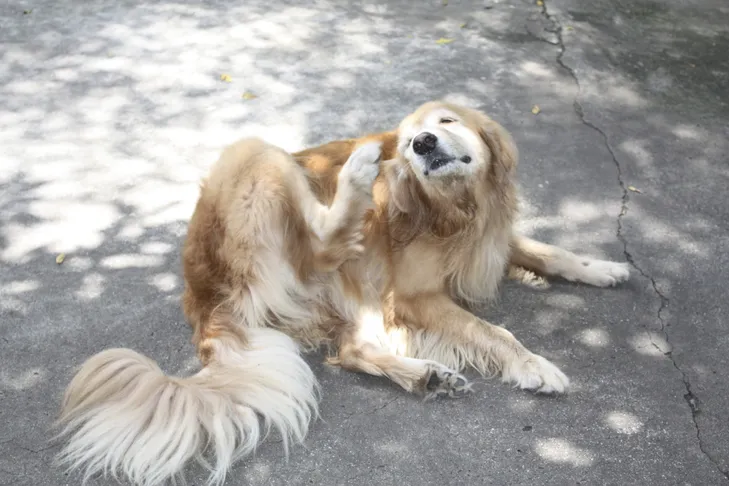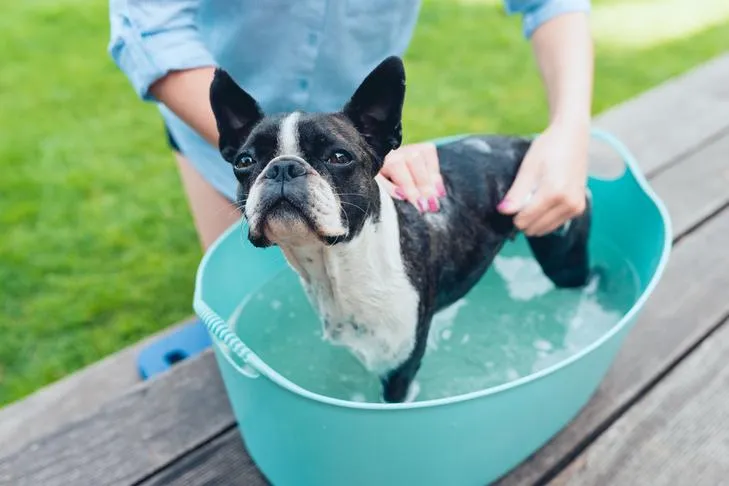If you’ve discovered your furry friend is battling a lice infestation, your mind might immediately jump to, “Can My Dog Get Lice From Me, or can I catch lice from my dog?” This is a common and understandable concern for any devoted pet parent. Fortunately, the answer is a reassuring “no.” Lice are highly species-specific, meaning the tiny parasites that thrive on your dog’s blood will not survive or transmit to you, and vice versa. However, this doesn’t mean lice infestations in dogs are trivial. They can cause significant discomfort and lead to more serious health issues if left untreated. Understanding dog lice, how they spread, and how to get rid of them is crucial for maintaining your dog’s well-being.
What Exactly Are Dog Lice?
Dog lice are small, wingless insects with six legs that live in the fur of mammals. Their specialized, hook-like claws are perfectly designed to cling to the hair shafts of their specific host, which is why they are unable to transfer between different species like humans and dogs. These parasites sustain themselves by feeding on skin debris, secretions, or the blood of their host animal.
There are two main categories of lice that can affect dogs:
Chewing Lice
As their name suggests, chewing lice feed on skin debris and surface secretions. They have a blunter, flatter head compared to their sucking counterparts. The two species of chewing lice commonly found on dogs and wild canids are Trichodectes canis and Heterodoxus spiniger. T. canis is prevalent globally and typically resides on its host for about 30 days. H. spiniger, on the other hand, is more common in tropical climates and has been observed on canids like coyotes, foxes, and wolves, with occasional sightings on domestic dogs.
Sucking Lice
Sucking lice require blood to survive. The primary species affecting dogs is Linognathus setosus. These lice possess a sharp, pointed mouthpart designed for piercing the skin and drawing blood. They are widespread in tropical and subtropical regions across the Americas, Africa, India, and Asia.
Recognizing the Signs of Dog Lice
Adult dog lice are relatively large, approximately the size of a sesame seed (2-4 millimeters), and can be seen with the naked eye. They typically range in color from yellow to tan or medium brown. To spot them, part your dog’s fur and examine the hair shafts. They are distinct from fleas, which are much darker.
Chewing lice tend to be more mobile, crawling through the fur, whereas sucking lice may embed their mouthparts into the skin, similar to ticks. If you suspect a lice infestation, using a flea comb can help you identify them and any accompanying eggs.
A common point of confusion for dog owners is mistaking lice eggs, or nits, for dandruff. A simple test can help differentiate: shake a sample of removed hair. If flakes fall off easily, it’s likely dandruff. If they remain stubbornly attached to the hair shaft, it’s probably lice. Beyond the visible signs, an infestation can manifest in several ways:
- Intense itching and scratching: This is often the most noticeable symptom.
- Rough, dry, or matted coat: The fur may lose its natural sheen and become unkempt.
- Hair loss: Patches of missing fur, particularly around the ears, neck, shoulders, groin, and rectal areas, are common.
- Skin lesions and infections: Bites from sucking lice can lead to small wounds and secondary bacterial infections.
- Restlessness and irritability: Your dog may seem constantly uncomfortable and agitated.
- Anemia: In severe cases, especially in puppies or smaller dogs, significant blood loss from sucking lice can lead to anemia.
- Secondary parasites and diseases: Lice can act as vectors, transmitting tapeworms and other pathogens.
 A Golden Retriever vigorously scratching its head with its hind leg while sitting in a grassy area. vichuda/Getty Images Plus via Getty Images
A Golden Retriever vigorously scratching its head with its hind leg while sitting in a grassy area. vichuda/Getty Images Plus via Getty Images
How Do Dogs Contract Lice?
Lice have limited mobility; they can crawl but cannot jump, hop, or fly. Adult lice typically die within a few days if they detach from their host. The most common mode of transmission is through direct contact with an infested animal. However, lice can also spread via contaminated environments such as bedding, dog collars, or shared grooming tools. This makes places where dogs gather, like doggy daycare, boarding kennels, and parks, potential hotspots for lice transmission.
The life cycle of a louse involves three stages: egg, nymph, and adult.
The cycle begins when a female louse lays tiny eggs, usually yellow or white, at the base of the hair shaft. These eggs are securely glued to the hair and are resistant to shampooing. After approximately one week, the eggs hatch, releasing immature lice called nymphs, which are barely visible to the naked eye. Another week later, these nymphs mature into adults, restarting the reproductive cycle. According to the Merck Veterinary Manual, it takes about three to four weeks for lice to progress from egg to reproductive adult.
 A Boston Terrier being bathed in a blue plastic tub outdoors with water splashing. ©bubutu – stock.adobe.com
A Boston Terrier being bathed in a blue plastic tub outdoors with water splashing. ©bubutu – stock.adobe.com
Effective Strategies for Eliminating Dog Lice
Fortunately, monthly flea and tick preventives have significantly reduced the incidence of lice in well-cared-for pet dogs. Lice infestations are now more commonly seen in dogs that are older, ill, stray, or feral.
For severe infestations, clipping matted hair is often recommended, as lice and eggs can be tightly attached and difficult to remove. After clipping, a flea comb can be used to remove remaining live and dead lice. However, a comb alone will not kill the eggs or prevent hatching. It’s essential to remember that after using a flea comb, it should be immersed in water mixed with a flea shampoo or other insecticide for at least ten minutes to kill any parasites on the comb.
Various insecticides are effective against dog lice, including Fipronil, imidacloprid, and selamectin. Topical permethrin can also be used with good results. As emphasized by Dr. Jerry Klein, AKC Chief Veterinarian, “Always ask your veterinarian about what products are safe to use on your dog based on his health, breed, and age.” Caution is also advised when using these products in households with cats, as many are toxic to felines.
Insecticide treatments, whether topical or in shampoos, are effective against nymphs and adults but will not eliminate the eggs. Therefore, any treatment regimen must be repeated at regular intervals for at least one month to break the life cycle. In a multi-dog household, it is imperative to treat all dogs simultaneously. It’s also crucial to isolate infested dogs and their bedding from other animals for at least four weeks post-treatment.
Thoroughly wash all bedding, dog sweaters, leashes, and collars in hot water. Clean all areas where the dogs spend time to prevent reinfestation. Some veterinarians suggest replacing grooming tools altogether, as the sticky eggs can be challenging to remove from brushes and combs.
Improving a dog’s overall health through better nutrition, regular grooming, and suitable housing can significantly contribute to preventing future louse infestations. By addressing the underlying health and environmental factors, you can create a less hospitable environment for these persistent parasites.
